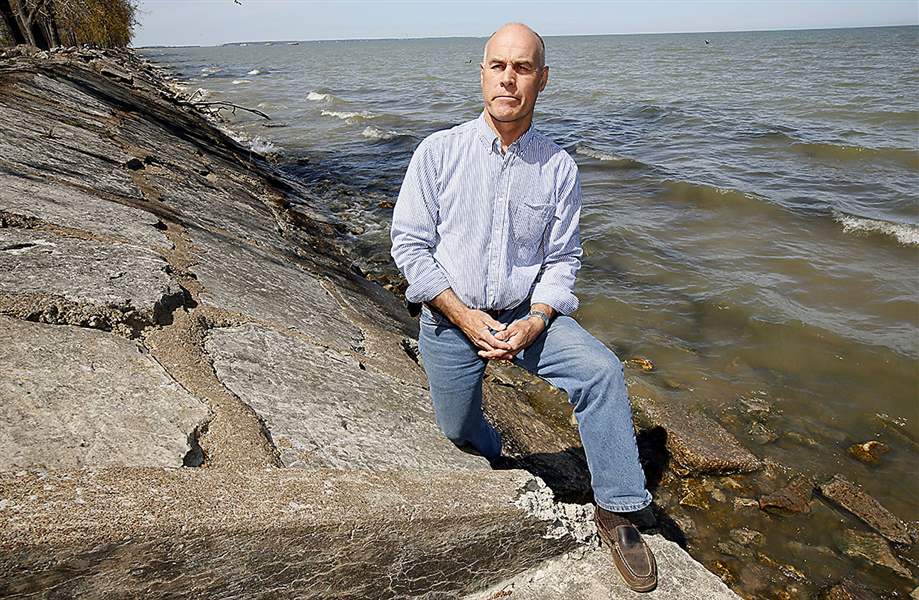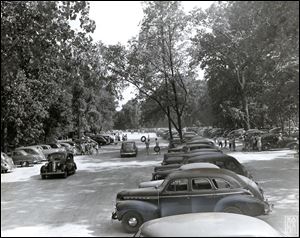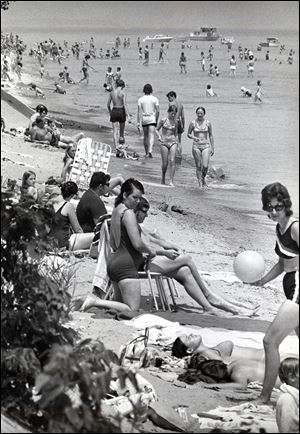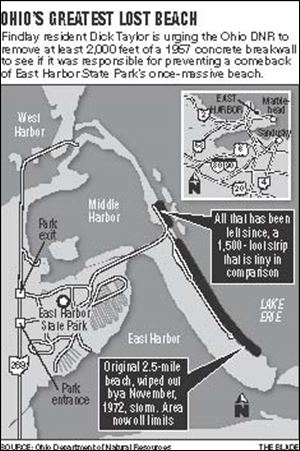
Findlay man spearheads mission to revive long-lost Lake Erie beach
5/11/2014
Dick Taylor of Findlay recalls cooling off on hot summer days at the beach at East Harbor State Park. Mr. Taylor suspects that this seawall erected by the state of Ohio and Army Corps of Engineers is preventing the area from making a comeback.
THE BLADE/JEREMY WADSWORTH
Buy This Image

Dick Taylor of Findlay recalls cooling off on hot summer days at the beach at East Harbor State Park. Mr. Taylor suspects that this seawall erected by the state of Ohio and Army Corps of Engineers is preventing the area from making a comeback.
MARBLEHEAD — Ohio’s best beach is, sadly, the one etched in distant memories of a past generation.
“I’ve seen people literally break down and cry when they think of what the beach at East Harbor State Park used to be and what’s not there now for their grandkids,” said Dick Taylor, who used to frequent the beach as a child.
Now a Findlay resident, Mr. Taylor is founder and president of a nonprofit group called BeachAid-East Harbor. He has tried for more than a decade to convince state officials that the park’s shoreline needs to be re-engineered to give the once-massive beach there a fighting chance at a comeback.
But he’s had little to show for his efforts — and faces an uphill battle with state officials, despite $88.5 million being made available for state park improvements over the next two years.
Huge slabs of concrete form a man-made breakwall, also known as a revetment or seawall, along East Harbor State Park’s southeastern peninsula.
They stand in place of where a Floridalike beach more than 2.5 miles long once drew 30,000 visitors a weekend between Memorial Day and Labor Day — so popular there were long traffic jams and 200 or more families would be turned away on a given day.
All that remains now is a 1,500-foot strip on the north end, an auxiliary beach that is barely a tenth of what East Harbor once had.

Cars pack the lot of just-opened East Harbor State Park in the late 1940s. The beach once drew 30,000 visitors a weekend between Memorial Day and Labor Day.
Need for funding
Placed along the East Harbor shoreline in 1957 by the Ohio Department of Natural Resources and the U.S. Army Corps of Engineers, the concrete structure hardened the shoreline.
It didn’t immediately cause the beach to erode.
Most of the beach was wiped out by a 1972 storm.
But Mr. Taylor and his supporters believe the man-made barrier has made it impossible for the beach to regenerate.
Now that the administration of Gov. John Kasich has announced it is planning to invest $88.5 million in capital improvements at Ohio’s 74 state parks during the next two years, Mr. Taylor has visions of an economic carrot being dangled in Columbus that could get his coveted project off the ground.
He is proposing that state officials spend $250,000 to remove 2,000 feet of the breakwall and conduct a five-year study of how the enhanced flow of water promotes more synergy between the lake and a sand dune.
Mr. Taylor is convinced such a pilot study would convince the Ohio Department of Natural Resources that removing the entire breakwall would regenerate at least a fair amount of the original beach, though perhaps not all of it.
He considers the vanished beach one of the greatest losses of public access to Lake Erie in Ohio’s history.
“It’s an ongoing process we don’t think is ever going to change with that seawall in there, interfering with the interaction between the waves and the dune,” Mr. Taylor said when he addressed the ODNR coastal resources advisory council earlier this month.

Swimmers and sunbathers enjoy the East Harbor beach four months before a storm destroyed it in 1972.
Eco-tourism
The whole issue of eco-tourism and outdoor recreation has received more attention in recent years, especially in states such as Ohio and Michigan that are trying to transform their legacies of heavy manufacturing and diversify their economies with more light-impact visitors who spend money on hotels, motels, and restaurants.
One example is the Biggest Week in American Birding, which continues through next week. It has brought thousands of birders to the Lake Erie shoreline to watch one of this region’s biggest weeks for bird migration.
Beaches are viewed as one of the biggest draws too.
A 1998 Ohio State University study concluded that half of Lake Erie’s daily beach visitors and more than two-thirds of the overnight visitors make substantial purchases within a 10-mile radius of the beaches they visit.
The idea of bigger, cleaner beaches is embraced by several tourism groups, such as the Ottawa County Visitors Bureau.
But there’s no guarantee Mr. Taylor’s plan would work. It would be costly.

Cost considerations
In 1981, the Corps of Engineers estimated that removing the entire breakwall would cost $5.6 million to $11.3 million.
The cost in today’s dollars is unknown.
But, according to Mr. Taylor’s research, the region has been losing $14 million to $15 million in recreation and tourism revenue each year since the beach vanished in 1972.
During those 42 years, shoreline property values have risen and beaches have become more valuable.
He said his demonstration project, if successful, would be a first step in averting massive losses in the future.
Seeking support
Ohio Sen. Randy Gardner (R., Bowling Green) said the project has potential.
“I think by the end of summer we will know a lot more about the advantages of this project and the level of interest the Ohio DNR has in it,” Mr. Gardner said. “It’s at least worth taking the next step.”
While Mr. Taylor appears to be getting support from some key players, there are signs he’s having trouble getting the ODNR’s top power brokers to embrace it.
Matt Eiselstein, the department’s spokesman, said there are myriad engineering and economic risks.
Officials are concerned what might happen if removing part of the structure would weaken the rest of it too much.
“There may be some benefit to it, but there also might be catastrophic results,” Mr. Eiselstein said. “It’s just not something we’re going to consider at this time.”
Glen Cobb, the department’s parks division chief, has declined to meet with Mr. Taylor. The agency said he was unavailable for an interview.
Although Mr. Eiselstein said the department has met numerous times with Mr. Taylor, he said he was not aware if any agency engineers have been looking into the pros and cons of removing the breakwall.
He said the agency was waiting for an engineering assessment from Mr. Taylor’s nonprofit group, which has little money for one.
“Without a plan or solid science behind it, it’s not something I’m sure we could pursue,” Mr. Eiselstein said.
Mr. Taylor said he remains hopeful, but he said he has picked up vibes from certain state officials that they’re not interested.
“They have pretty much just stopped responding to my phone, email, and letter correspondence,” he said.
Mr. Gardner, who met with Mr. Taylor recently for the first time, said he is “definitely going to consult with the Ohio DNR.”
An April 23 ODNR news release carried the following headline: “Unprecedented Investment in Ohio State Parks Announced Today.”
It went on to say how the $88.5 million would be used to improve state park facilities and lodges, as well as bathrooms and campsites.
The department said it is soliciting ideas for how the money should be spent at parks.ohiodnr.gov/improvements.
Not a priority?
Gail Hesse, Ohio Lake Erie Commission executive director, once said in an email to Mr. Taylor that she saw no point in meeting with him because she didn’t think the state of Ohio viewed his project as a priority.
Her commission is composed of state agency directors and is the state’s top Lake Erie advisory panel.
She told The Blade in an interview on Thursday that ODNR has to choose between the potential risk-reward of removing the breakwall and updating more basic items at state parks, such as campsites, electricity, and plumbing.
“You’ve got this long laundry list of state park needs. That could factor into it,” Ms. Hesse said.
Ultimately, it comes down to whether the breakwall has done more harm than good, she said.
“I think the concern would be what happens when the next big storm comes through,” Ms. Hesse said.
Viewpoints have conflicted about the need for and the effectiveness of that breakwall over the years.
The breakwall
While some at ODNR have defended it, one member of its coastal resources advisory council, Ed Herdendorf, a geologist, fisheries scientist, and professional underwater archaeologist, said the breakwall was placed in a bad location when it was installed in 1957.
“Yeah, I’d rip all of that stuff up and let it go natural,” Mr. Herdendorf said at the advisory council’s recent meeting.
Orrin Pilkey, a Duke University earth sciences professor who co-wrote a 1987 book about Lake Erie and a 1996 book that examined shoreline engineering projects across the country, said he’s surprised the breakwall was ever installed at East Harbor State Park because it wasn’t constructed to protect adjacent homes and businesses.
That’s the main purpose of breakwalls.
“You can have ocean shoreline or you can have shoreline buildings, but you can’t have both,” Mr. Pilkey said. “Seawalls almost always destroy beaches.”
Bruce Sanders, a Corps of Engineers spokesman, said the federal agency began a feasibility study on removing the breakwall years ago.
It came to a halt when ODNR — responsible for half of the funding — stopped putting money into it, he said.
The study probably could be picked up where it left off if ODNR resumed funding for it, Mr. Sanders said.
The Corps believes that restoring the barrier beach north of East Harbor State Park’s main parking lot is important too, because that will help protect a highly valuable, 670-acre coastal wetland marsh nearby for fish and wildlife.
According to a Corps fact sheet, Middle Harbor is one of three remaining marshes along the Lake Erie shoreline. “Middle Harbor is an important area for migratory birds and many species of fish. Additionally, the blanding turtle and tiger beetle, threatened state species, are found at Middle Harbor,” the Corps said.
Contact Tom Henry at: thenry@theblade.com or 419-724-6079.